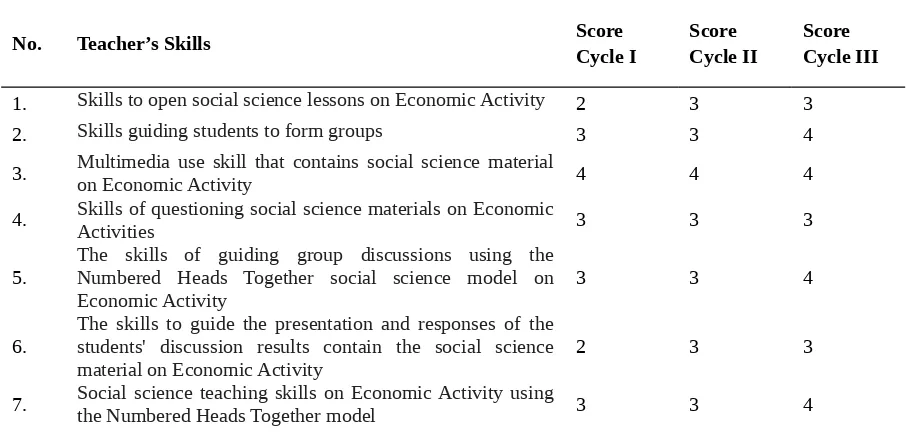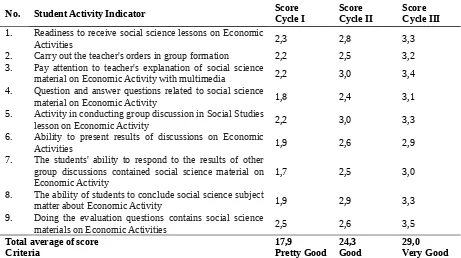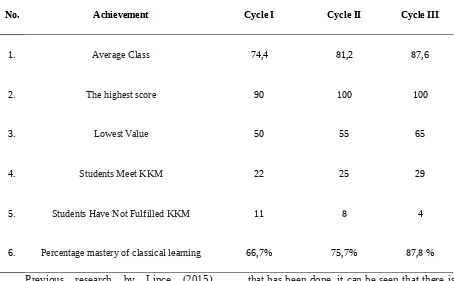THE APPLICATION OF NUMBERED HEADS TOGETHER MODEL ASSISTED
MULTIMEDIA TO IMPROVE SOCIAL SCIENCES LEARNING QUALITY
Abdillah Candra
, Susilo, Arif Widagdo
[email protected]
Department of Primary School Teacher Education, Faculty of Education, Semarang State University, Indonesia
Article Info
________________
________________ Keywords:
social science,
numbered head together,
learning,
multimedia
____________________
Abstract
___________________________________________________________________
This study aimed at improving social science quality through multimedia-assisted Numbered Heads Together model at 4D grade SDN 01 Ngaliyan Semarang. The design of the study was classroom action research in three cycles withone teaching session for each cycle. The subjects of the study were teacher and 4D grade students of SDN 01 Ngaliyan Semarang. The data were collected through testand nontest. The data were analized by using descriptive quantitative and qualitative analysis. The teacher skill in the first cycle obtained the scoredof 25 (good), in the second obtained the score of 28 (very good), and in the third obtained score of 32 (very good). Student activity in first cycle gained 17,9 (fair), in the second cycle it gained the score of 24,3 (good), and in the third cycle it gained the score of 29,0 (very good). The students learning achievement in the first cycle was 66.7% (not pass), in the second cycle obtained 75.7% (not pass), and in the third cycle obtained 87.8% (pass). The study concluded that the application of multimedia-assisted Numbered Heads Together model could improve the quality of social science learning at 4D grade SDN 01 Ngaliyan Semarang
1. INTRODUCTION
Improving the quality of education in Indonesia, national education should be able to ensure equal distribution of educational opportunities, quality improvement and relevance and efficiency of education management. Equity of educational opportunities is realized in the 9-year compulsory education program. Improving the quality of education is directed to improve the quality of Indonesian people completely through heart, mindset, taste and sport in order to have competitiveness in facing global challenges. Increased educational relevance is intended to produce graduates that match the demand-based needs of Indonesia's natural resources. Improving the efficiency of education management is done
through the implementation of school-based management and renewal of education management in a planned, directed and sustainable manner.
Based on observations and reflections conducted by researchers with partner teachers in social science learning in IVD class SDN Ngaliyan 01 Kota Semarang on Wednesday, October 16, 2014, found that the quality of social science learning is still low. Data from the observation on the skills of IVD teachers of SDN Ngaliyan 01 Semarang City in teaching that shows that teachers lack of interaction and communication with students, teachers still use the method of teaching lesson, rarely held variations of learning model, the teacher has not maximally utilized the media in learning.
Problems related to the activity of the students of grade IVD SDN Ngaliyan 01 Kota Semarang show that students do not actively participate in the learning so that the resulting learning achievement is low, the students only receive information only without the discussion activities, that making the students become quickly bored.
Evaluation on learning social science class IVD SDN Ngaliyan 01 Semarang City semester 1 2014/2015 shows the results achieved not maximal. Minimum completeness (KKM) determined by the school that is 70. Results of evaluation of 33 students, students who complete the KKM as many as 15 students (45.4%) and students are not complete as much as 18 students (54.6%). The low of teacher skill, student activity, and result of student learning of IVD class of SDN Ngaliyan 01 Semarang shows that the quality of social science learning is still low.
Based on the problems found by the researcher that is the low quality of learning in the class IVD SDN Ngaliyan 01 Kota Semarang, only some of the most important learning quality indicators to be improved are teacher skills, student activities and student learning outcomes.
Based on the researcher's discussion with the partner teacher on November 17th, 2014, to solve
the problem, the researcher and the partner teacher set an alternative action to improve the learning quality of social science KD 2.1 Recognize the economic activities related to natural resources and other potentials in the region. Applying the numbered heads together learning model to the social science lesson, the teacher can involve more students in group discussions with each student having a specific number to review the Economic Activity material covered in the Social science subjects and check their understanding of the social science learning lesson by calling the head number on students in a random manner, so that in the social science learning each student will be ready, can conduct the discussion seriously, students who are clever to teach students who are less intelligent, interaction occurs intense among students in answering questions and no students who dominate in groups because there is limiting numbers.
Learning social science through the use of multimedia will be more interesting, more interactive, the amount of teaching time can be faster, the quality of students can be improved, the learning process can be done anytime and anywhere, student attitudes can be improved. The application of learning model numbered heads together multimedia assisted more varied in social science learning and improve the interaction between teachers and students so that learning can run optimally. Earlier researchers who supported that the application of numbered heads-together models with multimedia aids can improve the quality of learning, among others: Doston (2001) indicates that Cooperative Learning Model Numbered Heads Together (NHT) can improve social science learning outcomes concept of social problems. Matthew Kearney (2009) shows the result that the use of multimedia in the classroom increases learning in science. teachers. This research is a classroom action research, in which the researcher also acts as an executive teacher of action. The subject of this research is teacher and students of IVD class of SDN Ngaliyan Kota Semarang as many as 33 students with 13 female students and 20 male students. Research variables very useful for teachers to improve the process and learning outcomes in the classroom. (Aqib, 2011). The implementation of classroom action research is done through four stages, namely planning, implementation, observation, and reflection. This research is done through 3 cycles with 1 meeting every cycle.
(observation, documentation and field notes). Quantitative data in this research is cognitive learning result data which is analyzed by using descriptive analysis technique with PAP approach. The first step is to determine the value based on theoretical scores using the formula:
N =
B
St
B
St
x 100Information: N = Value
B = Score obtained St = Theoretical score (Poerwanti, 2008)
After obtained the value, then the results of the calculation is consulted with the criteria of students' learning mastery which is categorized into two, that is complete (≥70)
and not complete (<70), according to social science SDN Ngaliyan 01 Semarang. The results of the calculation is consulted with the students' learning completeness criteria that are grouped into two complete and unfinished categories, with a classical completeness criterion of 85.
Qualitative data obtained from the observation of teacher skill and student activity in social science learning by using model of numbered heads together instructioned by multimedia in field note which then analyzed by qualitative descriptive analysis. The qualitative data are then presented in sentences separated by category to obtain conclusions. Qualitative data is processed by determining the lowest and highest score, then dividing the range of values into 4 categories that is very good, good, enough, and less.
3. RESULTS
Teacher skills, student activities, and learning outcomes of social science students in cycle I, II and III always increase. The following will illustrate the improvement of
teacher skill, student activity and writing skill in social science lesson with multimedia-assisted numbered heads-together model in cycles I, II, and III.
Teacher's Skills
Teachers' skills are the efforts undertaken by teachers through instructional materials directed to the cognitive changes of students in the improvement of social science learning
with the numbered heads together model assisted by multimedia. Recapitulation of score gain in each teacher skill cycle can be seen in table 1.
Table 1. Observation Results of Teacher Skills Improvement in Cycle I, II, and III
No. Teacher’s Skills Score
Cycle I
Score Cycle II
Score Cycle III
1. Skills to open social science lessons on Economic Activity 2 3 3
2. Skills guiding students to form groups 3 3 4
3. Multimedia use skill that contains social science materialon Economic Activity 4 4 4
4. Skills of questioning social science materials on EconomicActivities 3 3 3
5. The skills of guiding group discussions using theNumbered Heads Together social science model on
Economic Activity 3 3 4
6. The skills to guide the presentation and responses of thestudents' discussion results contain the social science
material on Economic Activity 2 3 3
8. Skills provide reinforcement 2 2 3
9. Skills close lessons 3 3 4
Total Score 25 27 32
Criteria Good Good VeryGood
Based on the results of observation table of teacher skill improvement on social science learning with numbered heads together model supported by multimedia from cycle I, II, and
III has increased. The percentage increase from cycle I to cycle II was 5.6%, and the percentage increase from cycle II to cycle III was 13%.
Student Activity
Student activity referred to in this research is all activities conducted in the process of interaction (teacher and student) that emphasizes students' physical activity, mental and intellectual emotional in order to
obtain maximum learning outcomes in learning social science with the model numbered heads together multimedia-assisted. Increased scores on each cycle of student activity can be seen in table 2.
Table 2. Results of Student Activity Improvement Activity in Cycle I, II, and III
No. Student Activity Indicator ScoreCycle I ScoreCycle II ScoreCycle III
1. Readiness to receive social science lessons on Economic
Activities 2,3 2,8 3,3
2. Carry out the teacher's orders in group formation 2,2 2,5 3,2
3. Pay attention to teacher's explanation of social science
material on Economic Activity with multimedia 2,2 3,0 3,4
4. Question and answer questions related to social science
material on Economic Activity 1,8 2,4 3,1
5. Activity in conducting group discussion in Social Studies
lesson on Economic Activity 2,2 3,0 3,3
6. Ability to present results of discussions on Economic
Activities 1,9 2,6 2,9
7. The students' ability to respond to the results of other group discussions contained social science material on
Economic Activity 1,7 2,5 3,0
8. The ability of students to conclude social science subject
matter about Economic Activity 1,9 2,9 3,3
9. Doing the evaluation questions contains social science
materials on Economic Activities 2,5 2,6 3,5
Total average of score 17,9 24,3 29,0
Criteria Pretty Good Good Very Good
Based on the observation table, the increase of student activity on social science learning with the numbered heads together model supported by multimedia from cycle I,
II, and III has increased. The percentage increase from cycle I to cycle II was 17.8%, and the percentage increase from cycle II to cycle III was 13.0%.
Learning Outcomes In Social Science Learning
Based on the research results can be seen that there is an increase in social science learning results by applying the model numbered heads together multimedia assisted from cycle I to cycle III. This is evidenced by the increase in the percentage of learning
is 85%. Results of student learning in each cycle can be seen in table 3.
Table 3. Increased Student Learning Results from cycle I, cycle II, and cycle III
No. Achievement Cycle I Cycle II Cycle III
1. Average Class 74,4 81,2 87,6
2. The highest score 90 100 100
3. Lowest Value 50 55 65
4. Students Meet KKM 22 25 29
5. Students Have Not Fulfilled KKM 11 8 4
6. Percentage mastery of classical learning 66,7% 75,7% 87,8 %
Previous research by Lince (2015) suggests that cooperative models can improve social attitudes. Ghaith (2010) found that this model can improve student learning outcomes in social science subjects. Hunter (2015) shows that the application of cooperative learning type numbered heads together can improve social science learning outcomes. Larry Maheady Ph.D (2013) states that the numbered heads together model with and without incentive packages for various group science test performance in the sixth grade. Todd Haydon (2010) suggests that the model numbered heads together on daily quiz scores and on the behavioral tasks of students with disabilities.
In this study proved that the model numbered heads together multimedia-assisted can also improve student learning outcomes in social science learning. Based on the research
that has been done, it can be seen that there is improvement of teacher skill, student activity, student learning result at social science learning in IVD class. This proves that the application of numbered heads together with multimedia assisted model is one of the effective efforts to improve the quality of social science learning in elementary school. This is because the model numbered heads together is a model that requires students to be ready and truly understand the material because the teacher can at any time point the student number at random. Through the model numbered heads together with the help of multimedia increasing the involvement of students actively in the learning process. This resulted in the knowledge obtained by students become more meaningful and impact on the increase of student learning outcomes.
CONCLUSIONS
Based on the analysis and discussion of the results of classroom action research conducted on the students of grade IVD SDN Ngaliyan 01 Kota Semarang Indonesia in the study of social science with the model
learning outcomes, then this study was declared successful
.
REFERENCES
Aqib, Zaenal. 2011. Penelitian Tindakan Kelas. Bandung: Yrama Widya.
Doston, Jeanie M. 2001. Cooperative Learning Structures Can Increase Student Achievement. San Clemente : Kagan Publishing
Ghaith, Ghazi. 2010. Effects of the Learning Together Model of Cooperative Learning on English as a Foreign Language Reading Achievement, Academic SelfEsteem, and Feelings of School Alienation. Billingual Research Journal. 27(2) : 451-474
Haydon, Todd, dkk. 2010. Effects of Numbered Heads Together on the Daily Quiz Scores and On-Task Behavior of Students with Disabilities. Journal of Behavioral Education. 19: 222-238
Hunter, William C. 2015. Numbered Heads Together as a Tier 1 Instructional Strategy in Multitiered Systems of Support. Education and Treatment of Children. 38(3): 345-362
Kearney, Matthew. 2009. Classroom Use of Multimedia-Supported Predict–Observe– Explain Tasks in a Social Constructivist Learning Environment. Journal of Science Education. 34(4):427-453
Lince, Ranak. 2014. Creative Thinking Ability to Increase Student Mathematical of Junior High School by Applying Models Numbered Heads Together. Journal of Education and Practice. 7(6) : 2016-212. Maheady, Larry Ph.D., dkk. 2013. The Effects
of Numbered Heads Together with and Without an Incentive Package on the Science Test Performance of a Diverse Group of Sixth Graders. Journal of Behavioral Education. 15(1):25-39


